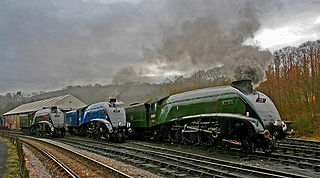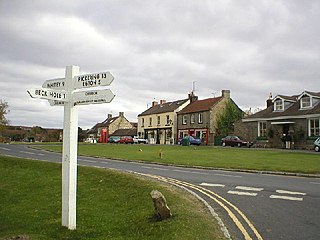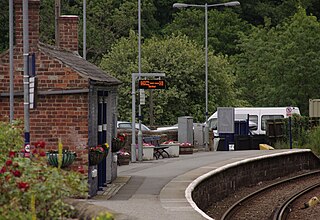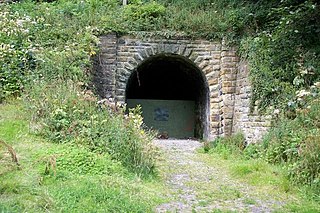
The North Yorkshire Moors Railway (NYMR) is a heritage railway in North Yorkshire, England, that runs through the North York Moors National Park. First opened in 1836 as the Whitby and Pickering Railway, the railway was planned in 1831 by George Stephenson as a means of opening up trade routes inland from the then important seaport of Whitby. The line between Grosmont and Rillington was closed in 1965 and the section between Grosmont and Pickering was reopened in 1973 by the North York Moors Historical Railway Trust Ltd. The preserved line is now a tourist attraction and has been awarded several industry accolades.

Goathland is a village and civil parish in the Scarborough district of North Yorkshire, England. Historically part of the North Riding of Yorkshire, it is in the North York Moors national park due north of Pickering, off the A169 to Whitby. It has a station on the steam-operated North Yorkshire Moors Railway line.

Gypsy Lane is a railway station on the Esk Valley Line, which runs between Middlesbrough and Whitby via Nunthorpe. The station, situated 4 miles 3 chains (6.5 km) south-east of Middlesbrough, serves the suburb of Nunthorpe, Redcar and Cleveland in North Yorkshire, England. It is owned by Network Rail and managed by Northern Trains.

Grosmont is a railway station on the Esk Valley Line, which runs between Middlesbrough and Whitby via Nunthorpe. The station, situated 6 miles 24 chains (10.1 km) west of Whitby, serves the village of Grosmont, in the Borough of Scarborough, North Yorkshire, England. It is owned by Network Rail and managed by Northern Trains. The station is also served by heritage services operated by the North Yorkshire Moors Railway.

Sleights is a railway station on the Esk Valley Line, which runs between Middlesbrough and Whitby via Nunthorpe. The station, situated 2 miles 78 chains (4.8 km) south-west of Whitby, serves the villages of Briggswath and Sleights, Scarborough in North Yorkshire, England. It is owned by Network Rail and managed by Northern Trains.

Ruswarp is a railway station on the Esk Valley Line, which runs between Middlesbrough and Whitby via Nunthorpe. The station, situated 1 mile 30 chains (2.2 km) south-west of Whitby, serves the village of Ruswarp, Scarborough in North Yorkshire, England. It is owned by Network Rail and managed by Northern Trains.

Pickering railway station is the southern terminus of the North Yorkshire Moors Railway and serves the town of Pickering in North Yorkshire, England. The first railway arrived in Pickering from the north in 1836, however, it wasn't until the railway was connected from the south in 1845, that the current station was built. The station was closed by British Railways in March 1965, but since 1975, the station has served as the southern terminus of the North York Moors Railway.

Levisham railway station is a station on the North Yorkshire Moors Railway and serves the village of Levisham in the North York Moors National Park, North Yorkshire, England.

Newton Dale Halt railway station is a request stop on the North Yorkshire Moors Railway and serves as a stopping off point for walkers around Newton Dale and Cropton Forest in the North York Moors National Park, North Yorkshire, England. When the station was opened, the station signs were written as Newtondale Halt.

Goathland railway station is a station on the North Yorkshire Moors Railway and serves the village of Goathland in the North York Moors National Park, North Yorkshire, England. It has also been used in numerous television and film productions. Holiday accommodation is available in the form of a camping coach.

Beck Hole is a small valley village in the former Borough of Scarborough, North Yorkshire, England. The village lies within the Goathland civil parish and the North York Moors national park.

The Whitby, Redcar and Middlesbrough Union Railway (WRMU), a.k.a. the Whitby–Loftus Line, was a railway line in North Yorkshire, England, built between 1871 and 1886, running from Loftus on the Yorkshire coast to the Esk at Whitby, and connecting Middlesbrough to Whitby along the coast.
The Forge Valley Line was a 16-mile-long branch of the North Eastern Railway between Seamer and Pickering in North Yorkshire, England. The line was intended to link Scarborough with Pickering. It opened in 1882 and closed in 1950, with the exception of a stretch from Pickering to Thornton Dale which remained open for quarry traffic until 1963.

Hinderwell railway station was a railway station on the Whitby Redcar and Middlesbrough Union Railway. It was opened on 3 December 1883, and served the villages of Hinderwell and Runswick Bay. Like most stations on the line between Loftus and Whitby West Cliff, it was built with a passing loop. However, the northbound side was not furnished with a platform until 1908. The station closed to all traffic on 5 May 1958.

The Whitby and Pickering Railway (W&P) was built to halt the gradual decline of the port of Whitby on the east coast of England. Its basic industries—whaling and shipbuilding—had been in decline and it was believed that opening transport links inland would help regenerate the town and port.

Beckhole railway station was a railway station at Beck Hole in the North Yorkshire Moors on part of the original Whitby and Pickering Railway line. Although it was possible to travel to Beckhole in 1835, the station was opened in 1836, and closed to passengers permanently in 1914. Beckhole closed completely in 1951.
The Rosedale Railway was a 19.5-mile (31.4 km) goods-only railway line running from Battersby Junction via Ingleby Incline, across the heights of the North York Moors in North Yorkshire, England to reach iron ore deposits in the remote hills of the Rosedale valley. It opened to traffic as a narrow gauge railway to Ingleby Incline top in 1858, converted to standard gauge and opened to Rosedale West in 1861, and closed completely in 1929. Apart from Ingleby Incline, no major engineering works were constructed, and as such, particularly the east branch, the railway followed the contours of the surrounding hillside. The former trackbeds of the railway are in use by walkers and cyclists.

Helmsley railway station served the market town of Helmsley in North Yorkshire from 1871 until 1964, although the regular passenger service ceased in 1953. Helmsley station was nearly 15 miles (24 km) from Pilmoor station on the East Coast Main Line, and 12 miles (19 km) from Pickering.

Whitby engine shed was a steam locomotive depot located at the south end of Whitby railway station in North Yorkshire, England. The shed was opened in 1847, extended in the 1860s, and closed in 1959, when the closure of lines and dieselisation of the routes from Whitby took hold. The shed building, which was grade II listed in 1991, still stands, being utilised for various enterprises, and is now used as holiday accommodation.

Beckhole Incline was a steep, rope-worked gradient on the railway line between Whitby and Pickering, in the North Riding of Yorkshire, England. Opened in May 1836 as part of the horse-worked Whitby & Pickering Railway, the line was operated by three railway companies before becoming redundant on the opening of a diversionary line to the east that allowed through working by steam engines on the entire line. Although the incline was closed to regular traffic in 1865, it was used for a very brief period in 1872, to test a special locomotive intended for railways with steep gradients.



















